Historic jewelry has always captivated me. I’d stare at the pictures in the encyclopedia
of the necklaces, rings, and crowns the Royals wore during the
renaissance. I’d let my mind wander to a place I knew nothing about and wondered
what these pieces of jewelry had seen or where they’d been. Museums do the same
thing to me when I see other ruins from a time I could only imagine, but I'll save that for another post.
 |
| Dainty ring could be used to conceal keepsakes. c.1880 |
I’ve been researching a ton lately for my
final book in the Branded Trilogy that takes place in the American Colonies
during the 1700’s.
As I was rummaging through pages and pages of history, I
came across an odd, but very fascinating piece of jewelry called a box ring, or
also known as a locket ring.
These were very popular throughout Europe during
the sixteenth century. The rings were used to store many things from perfume, a
lock of hair, messages and devotional relics. They were fashionable and most of
the wealthy had one.
The locket ring came to Europe from Asia,
Russia and the Middle East during the Holy Trade.
The Poison ring had been used long before as a means to an end for those in captivity, or before being
 |
| Lucrezia Borgia |
The poison rings became sought after pieces
of jewelry during war to elude capture, but also if the opportunity arose to
poison your enemy. Rulers used these infamous rings to hide arsenic and poison
their political rivals.
Lucrezia
Borgia, the daughter of Cardinal Rodrigo Borgia (who later became Pope
Alexander VI). The Borgia family was very powerful and
wealthy. The Cardinal used his daughter as a pawn of trade to further the family’s
status on the political ladder. But some would say Lucrezia was not to be toyed
with. She owned an array of poison rings using them often at family
parties.
 |
| Believed to be used by Bulgarian noble Dobrotitsa c.1400's |
The poison ring was made with intercut
detail. How one wanted to dispense the poison from inside depended on the rings
construction.
For example some rings had a tiny hole drilled into the left, or
right side depending on which hand you wore it, where the poison could be
dispensed into a glass of wine. The wearer would simply remove the inside
finger covering the hole and dump the contents out.
 |
| Late 1800's Poison Ring. |
Other rings had a lever that when pressed
with the inside of the finger would open the top of the bezel.
During the reign of Queen Elizabeth I, a more morbid style of ring emerged. Jewellers began making coffin style locket rings with images of skeletons and death inside. These were called Funeral, or Mourning rings and given to mourners to remember their departed.
I'm not sure I'd wear any of these rings...but I'd love to know where they've been.
Happy Friday, Friends!!
Kat


Cool post, Kat. I always wondered how the poison ring worked. When you see them in movies, they aren't in the least bit discrete.
ReplyDeleteI'm in love with the locket ring you show. It's beautiful. That's gold in polished quartz, isn't it?
I knew about Lucretia Borgia but didn't realize the poison rings were used so widely. No wonder kings and queens had tasters--a job I would not want! Interesting post.
ReplyDeleteThanks, Ladies. :) I agree Ali, in the movies poison rings were definitely not discrete, but they were in fact a hidden gem back then. The locket ring is my favourite too! I believe it is gold quartz.
ReplyDeleteCaroline, I read about the tasters and I am with you 100%. I would not want that job!